Sipeng Zheng
Being-M0.5: A Real-Time Controllable Vision-Language-Motion Model
Aug 11, 2025Abstract:Human motion generation has emerged as a critical technology with transformative potential for real-world applications. However, existing vision-language-motion models (VLMMs) face significant limitations that hinder their practical deployment. We identify controllability as a main bottleneck, manifesting in five key aspects: inadequate response to diverse human commands, limited pose initialization capabilities, poor performance on long-term sequences, insufficient handling of unseen scenarios, and lack of fine-grained control over individual body parts. To overcome these limitations, we present Being-M0.5, the first real-time, controllable VLMM that achieves state-of-the-art performance across multiple motion generation tasks. Our approach is built upon HuMo100M, the largest and most comprehensive human motion dataset to date, comprising over 5 million self-collected motion sequences, 100 million multi-task instructional instances, and detailed part-level annotations that address a critical gap in existing datasets. We introduce a novel part-aware residual quantization technique for motion tokenization that enables precise, granular control over individual body parts during generation. Extensive experimental validation demonstrates Being-M0.5's superior performance across diverse motion benchmarks, while comprehensive efficiency analysis confirms its real-time capabilities. Our contributions include design insights and detailed computational analysis to guide future development of practical motion generators. We believe that HuMo100M and Being-M0.5 represent significant advances that will accelerate the adoption of motion generation technologies in real-world applications. The project page is available at https://beingbeyond.github.io/Being-M0.5.
RL from Physical Feedback: Aligning Large Motion Models with Humanoid Control
Jun 15, 2025Abstract:This paper focuses on a critical challenge in robotics: translating text-driven human motions into executable actions for humanoid robots, enabling efficient and cost-effective learning of new behaviors. While existing text-to-motion generation methods achieve semantic alignment between language and motion, they often produce kinematically or physically infeasible motions unsuitable for real-world deployment. To bridge this sim-to-real gap, we propose Reinforcement Learning from Physical Feedback (RLPF), a novel framework that integrates physics-aware motion evaluation with text-conditioned motion generation. RLPF employs a motion tracking policy to assess feasibility in a physics simulator, generating rewards for fine-tuning the motion generator. Furthermore, RLPF introduces an alignment verification module to preserve semantic fidelity to text instructions. This joint optimization ensures both physical plausibility and instruction alignment. Extensive experiments show that RLPF greatly outperforms baseline methods in generating physically feasible motions while maintaining semantic correspondence with text instruction, enabling successful deployment on real humanoid robots.
EgoDTM: Towards 3D-Aware Egocentric Video-Language Pretraining
Mar 19, 2025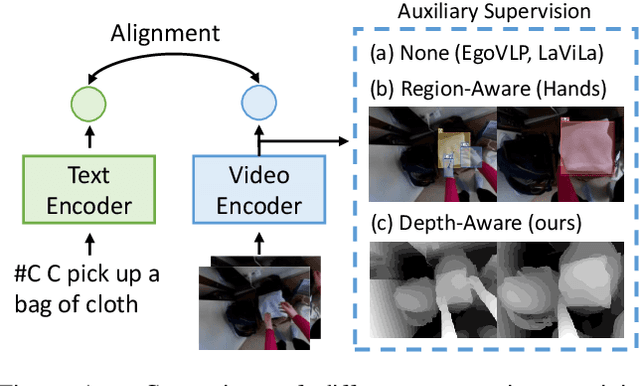

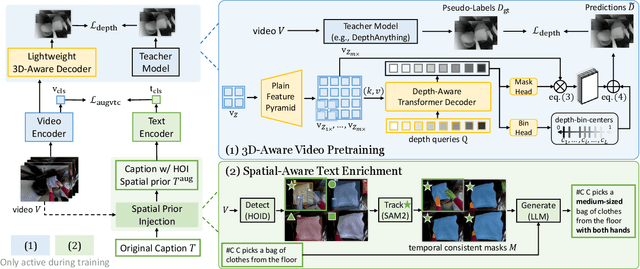

Abstract:Egocentric video-language pretraining has significantly advanced video representation learning. Humans perceive and interact with a fully 3D world, developing spatial awareness that extends beyond text-based understanding. However, most previous works learn from 1D text or 2D visual cues, such as bounding boxes, which inherently lack 3D understanding. To bridge this gap, we introduce EgoDTM, an Egocentric Depth- and Text-aware Model, jointly trained through large-scale 3D-aware video pretraining and video-text contrastive learning. EgoDTM incorporates a lightweight 3D-aware decoder to efficiently learn 3D-awareness from pseudo depth maps generated by depth estimation models. To further facilitate 3D-aware video pretraining, we enrich the original brief captions with hand-object visual cues by organically combining several foundation models. Extensive experiments demonstrate EgoDTM's superior performance across diverse downstream tasks, highlighting its superior 3D-aware visual understanding. Our code will be released at https://github.com/xuboshen/EgoDTM.
Taking Notes Brings Focus? Towards Multi-Turn Multimodal Dialogue Learning
Mar 10, 2025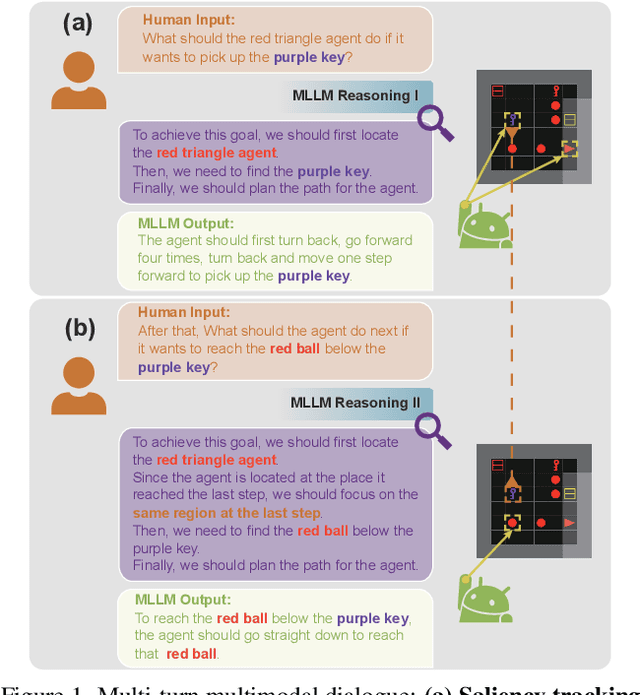



Abstract:Multimodal large language models (MLLMs), built on large-scale pre-trained vision towers and language models, have shown great capabilities in multimodal understanding. However, most existing MLLMs are trained on single-turn vision question-answering tasks, which do not accurately reflect real-world human conversations. In this paper, we introduce MMDiag, a multi-turn multimodal dialogue dataset. This dataset is collaboratively generated through deliberately designed rules and GPT assistance, featuring strong correlations between questions, between questions and images, and among different image regions; thus aligning more closely with real-world scenarios. MMDiag serves as a strong benchmark for multi-turn multimodal dialogue learning and brings more challenges to the grounding and reasoning capabilities of MLLMs. Further, inspired by human vision processing, we present DiagNote, an MLLM equipped with multimodal grounding and reasoning capabilities. DiagNote consists of two modules (Deliberate and Gaze) interacting with each other to perform Chain-of-Thought and annotations respectively, throughout multi-turn dialogues. We empirically demonstrate the advantages of DiagNote in both grounding and jointly processing and reasoning with vision and language information over existing MLLMs.
VideoOrion: Tokenizing Object Dynamics in Videos
Nov 25, 2024Abstract:We present VideoOrion, a Video Large Language Model (Video-LLM) that explicitly captures the key semantic information in videos--the spatial-temporal dynamics of objects throughout the videos. VideoOrion employs expert vision models to extract object dynamics through a detect-segment-track pipeline, encoding them into a set of object tokens by aggregating spatial-temporal object features. Our method addresses the persistent challenge in Video-LLMs of efficiently compressing high-dimensional video data into semantic tokens that are comprehensible to LLMs. Compared to prior methods which resort to downsampling the original video or aggregating visual tokens using resamplers, leading to information loss and entangled semantics, VideoOrion not only offers a more natural and efficient way to derive compact, disentangled semantic representations but also enables explicit object modeling of video content with minimal computational cost. Moreover, the introduced object tokens naturally allow VideoOrion to accomplish video-based referring tasks. Experimental results show that VideoOrion can learn to make good use of the object tokens, and achieves competitive results on both general video question answering and video-based referring benchmarks.
Quo Vadis, Motion Generation? From Large Language Models to Large Motion Models
Oct 04, 2024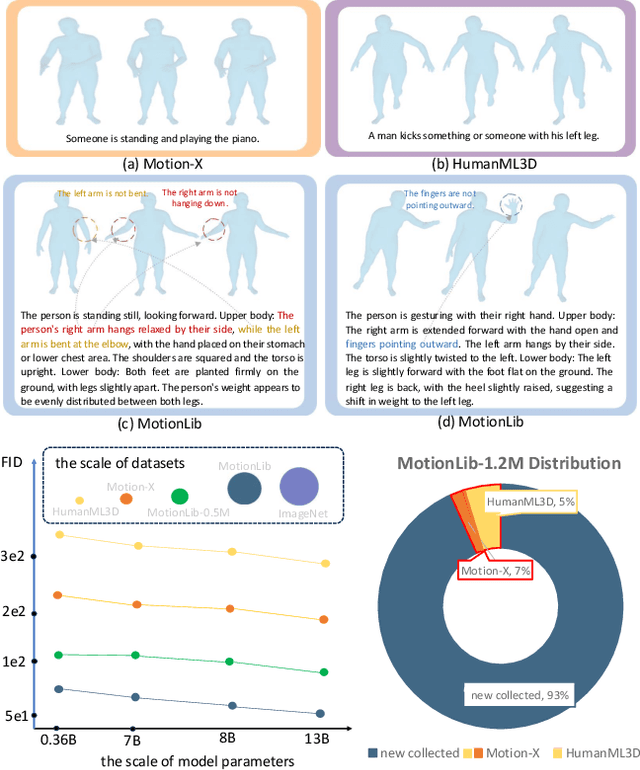

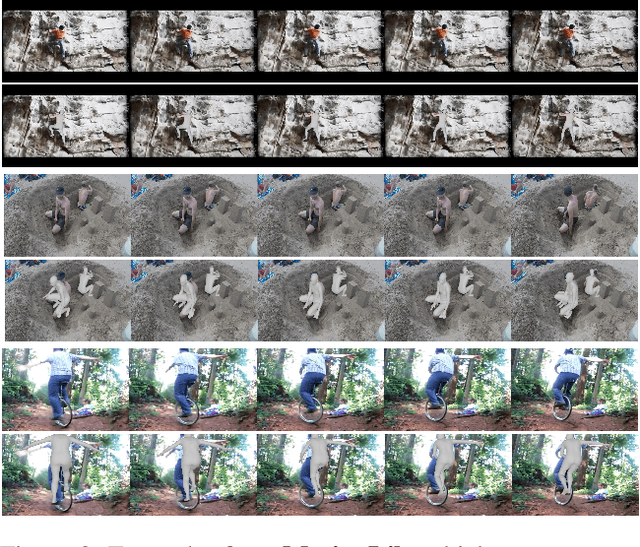
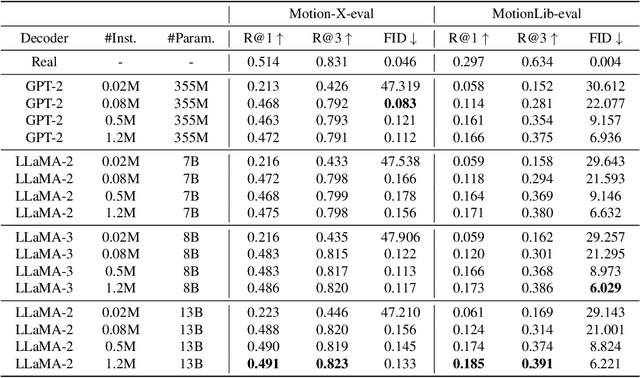
Abstract:Inspired by the recent success of LLMs, the field of human motion understanding has increasingly shifted towards the development of large motion models. Despite some progress, current state-of-the-art works remain far from achieving truly generalist models, largely due to the lack of large-scale, high-quality motion data. To address this, we present MotionBase, the first million-level motion generation benchmark, offering 15 times the data volume of the previous largest dataset, and featuring multimodal data with hierarchically detailed text descriptions. By leveraging this vast dataset, our large motion model demonstrates strong performance across a broad range of motions, including unseen ones. Through systematic investigation, we underscore the importance of scaling both data and model size, with synthetic data and pseudo labels playing a crucial role in mitigating data acquisition costs. Moreover, our research reveals the limitations of existing evaluation metrics, particularly in handling out-of-domain text instructions -- an issue that has long been overlooked. In addition to these, we introduce a novel 2D lookup-free approach for motion tokenization, which preserves motion information and expands codebook capacity, further enhancing the representative ability of large motion models. The release of MotionBase and the insights gained from this study are expected to pave the way for the development of more powerful and versatile motion generation models.
From Pixels to Tokens: Byte-Pair Encoding on Quantized Visual Modalities
Oct 03, 2024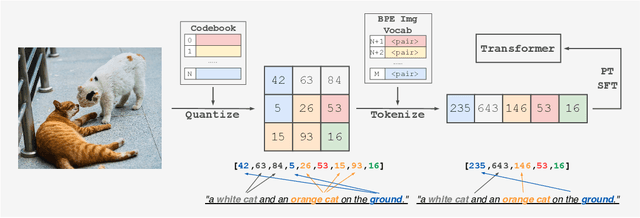



Abstract:Multimodal Large Language Models have made significant strides in integrating visual and textual information, yet they often struggle with effectively aligning these modalities. We introduce a novel image tokenizer that bridges this gap by applying the principle of Byte-Pair Encoding (BPE) to visual data. Unlike conventional approaches that rely on separate visual encoders, our method directly incorporates structural prior information into image tokens, mirroring the successful tokenization strategies used in text-only Large Language Models. This innovative approach enables Transformer models to more effectively learn and reason across modalities. Through theoretical analysis and extensive experiments, we demonstrate that our BPE Image Tokenizer significantly enhances MLLMs' multimodal understanding capabilities, even with limited training data. Our method not only improves performance across various benchmarks but also shows promising scalability, potentially paving the way for more efficient and capable multimodal foundation models.
QuadrupedGPT: Towards a Versatile Quadruped Agent in Open-ended Worlds
Jun 24, 2024
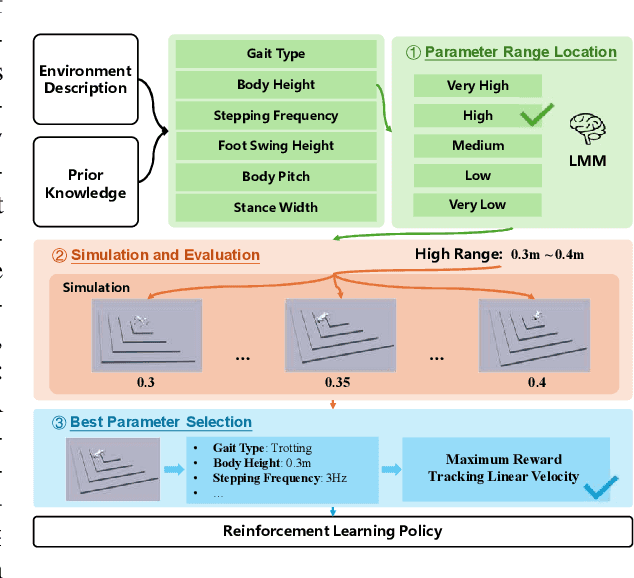

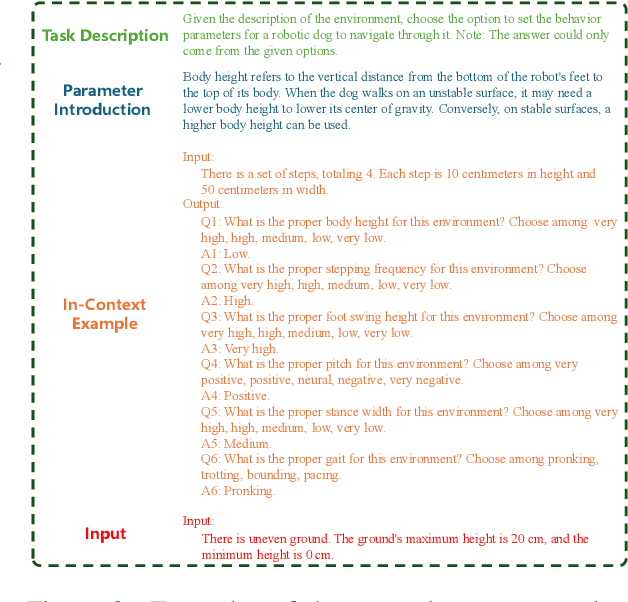
Abstract:While pets offer companionship, their limited intelligence restricts advanced reasoning and autonomous interaction with humans. Considering this, we propose QuadrupedGPT, a versatile agent designed to master a broad range of complex tasks with agility comparable to that of a pet. To achieve this goal, the primary challenges include: i) effectively leveraging multimodal observations for decision-making; ii) mastering agile control of locomotion and path planning; iii) developing advanced cognition to execute long-term objectives. QuadrupedGPT processes human command and environmental contexts using a large multimodal model (LMM). Empowered by its extensive knowledge base, our agent autonomously assigns appropriate parameters for adaptive locomotion policies and guides the agent in planning a safe but efficient path towards the goal, utilizing semantic-aware terrain analysis. Moreover, QuadrupedGPT is equipped with problem-solving capabilities that enable it to decompose long-term goals into a sequence of executable subgoals through high-level reasoning. Extensive experiments across various benchmarks confirm that QuadrupedGPT can adeptly handle multiple tasks with intricate instructions, demonstrating a significant step towards the versatile quadruped agents in open-ended worlds. Our website and codes can be found at https://quadruped-hub.github.io/Quadruped-GPT/.
EgoNCE++: Do Egocentric Video-Language Models Really Understand Hand-Object Interactions?
May 28, 2024Abstract:Egocentric video-language pretraining is a crucial paradigm to advance the learning of egocentric hand-object interactions (EgoHOI). Despite the great success on existing testbeds, these benchmarks focus more on closed-set visual concepts or limited scenarios. Due to the occurrence of diverse EgoHOIs in the real world, we propose an open-vocabulary benchmark named EgoHOIBench to reveal the diminished performance of current egocentric video-language models (EgoVLM) on fined-grained concepts, indicating that these models still lack a full spectrum of egocentric understanding. We attribute this performance gap to insufficient fine-grained supervision and strong bias towards understanding objects rather than temporal dynamics in current methods. To tackle these issues, we introduce a novel asymmetric contrastive objective for EgoHOI named EgoNCE++. For video-to-text loss, we enhance text supervision through the generation of negative captions by leveraging the in-context learning of large language models to perform HOI-related word substitution. For text-to-video loss, we propose an object-centric positive video sampling strategy that aggregates video representations by the same nouns. Our extensive experiments demonstrate that EgoNCE++ significantly boosts open-vocabulary HOI recognition, multi-instance retrieval, and action recognition tasks across various egocentric models, with improvements of up to +26.55%. Our code is available at https://github.com/xuboshen/EgoNCEpp.
UniCode: Learning a Unified Codebook for Multimodal Large Language Models
Mar 14, 2024Abstract:In this paper, we propose \textbf{UniCode}, a novel approach within the domain of multimodal large language models (MLLMs) that learns a unified codebook to efficiently tokenize visual, text, and potentially other types of signals. This innovation addresses a critical limitation in existing MLLMs: their reliance on a text-only codebook, which restricts MLLM's ability to generate images and texts in a multimodal context. Towards this end, we propose a language-driven iterative training paradigm, coupled with an in-context pre-training task we term ``image decompression'', enabling our model to interpret compressed visual data and generate high-quality images.The unified codebook empowers our model to extend visual instruction tuning to non-linguistic generation tasks. Moreover, UniCode is adaptable to diverse stacked quantization approaches in order to compress visual signals into a more compact token representation. Despite using significantly fewer parameters and less data during training, Unicode demonstrates promising capabilities in visual reconstruction and generation. It also achieves performances comparable to leading MLLMs across a spectrum of VQA benchmarks.
 Add to Chrome
Add to Chrome Add to Firefox
Add to Firefox Add to Edge
Add to Edge